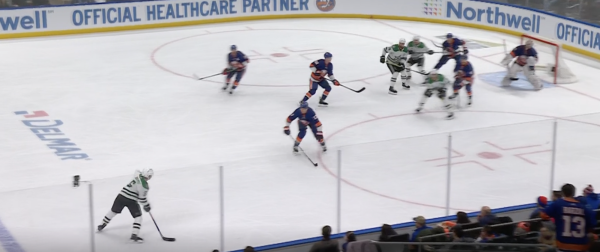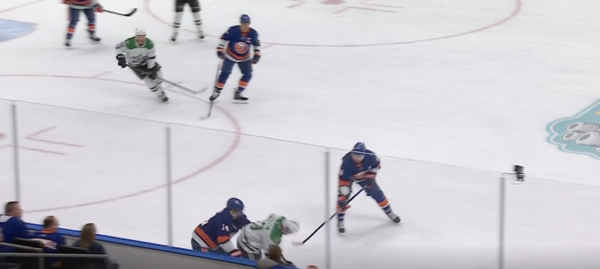
After the New York Islanders celebrated a come-from-behind 3-2 overtime win against the talented Dallas Stars, head coach Patrick Roy was asked if he thought that the minute tweaks he made at morning skate came through during the game.
"We were much better on our second quick," Roy said. "Even offensively and defensively, I thought we were quicker."
Second quick. What on earth does that mean?
Glad you asked.
The second quick is discussing support, and for the Islanders, we are going to hear it a lot when Roy discusses their defensive-zone system.
Whether it's seeing two guys converge on a player in the corner or at the top of the zone, it just means that when players have the opportunity to provide extra support -- without leaving their assignments -- they do it quickly to apply added pressure.
Here's an example: As you watch the Winnipeg Jets showcase that "second quick" at the top of the zone during the Tampa Bay Lightning cycle, as soon as the puck goes to the next player, the high forward stays with his guy, but a quick-pinch effort is made to force Tampa to move the puck quicker.
When pressure is applied aggressively, it could lead to turnovers, which leads to quicker breakouts, or at the very least, keeps the offense to the outside to make life easier for the defensemen and goaltenders:
The Islanders allowed 41 shots on Ilya Sorokin Sunday night, with Roy pointing out that 17 came off turnovers.
But if you watched the game, the Islanders lacked aggressiveness at times, especially at the point when the Stars were given too much time and space to make plays and get high-danger shots.
For Roy to get the Islanders to have an elite "second step" mindset, he must break old habits.
And old habits die hard.
"I think we could be even better if our defensemen...our defensemen are a little afraid to leave the net front. I mean, these are the habits that they have had for a long time," Roy said. "Adam [Pelech] was starting to go, leaving the net front and going. It's just normal. It's a trust thing. We need to trust each other, and the defense needs to trust the forwards, and the forwards need to trust the defensemen, so we're gonna be more comfortable.
"We're gonna have a lot more heavy pressure in the defensive zone. And I think that's gonna help our team breakout and [spend] less time in our zone. I haven't seen the possession, but I thought that I didn't have a moment where I was like, 'Okay, can we get the puck out, leave the zone?' I thought we did some good stuff with our defensive zone coverage."
Remember that shell under Barry Trotz? This formula under Roy undermines that mindset.
Rather than having the defensemen shell up in the low slot -- in theory, to limit shooting lanes -- which the Islanders failed to do at an alarming rate under Lane Lambert -- Roy wants them exploding outward.
Here's an example during the second period, where you can see how deep the Islanders are when the puck is at the point, with Matt Martin the only one going toward the point man Nils Lundkvist:

Here's an example of a strong "first quick" in the second half of the third period, where Bo Horvat tried to tie up Wyatt Johnson before Julien Gauthier came in as relief:

Gauthier wasn't able to make the play, but it's clear as the game went on that Roy's tweaks were starting to come to the surface at a higher rate.
One area of the Islanders game Sunday night that was night and day was their penalty kill, which had been abysmal this season.
The Stars failed to score on any of their three power-play chances, with New York allowing six shots on goal, with just one being considered a high-danger shot, per NaturalStatrick.com.
Although the "second quick" mindset on the penalty kill could lead to some self-destruction, already being down a man, aggressive penalty kills, if operated correctly, are effective, and the Islanders may be able to pull it off.
So, that's your little hockey less of the day, so study up.
There will be a quiz coming up, and given Roy's explanations during his first postgame press conference, we are all going to learn a lot more about the Xs and Os of the sport as the season progresses.
You can watch Rosner talk Islanders hockey on Hockey Night in New York with co-host Sean Cuthbert live Sunday nights at 8 PM ET during the season on Twitch, YouTube, Twitter & Facebook.

